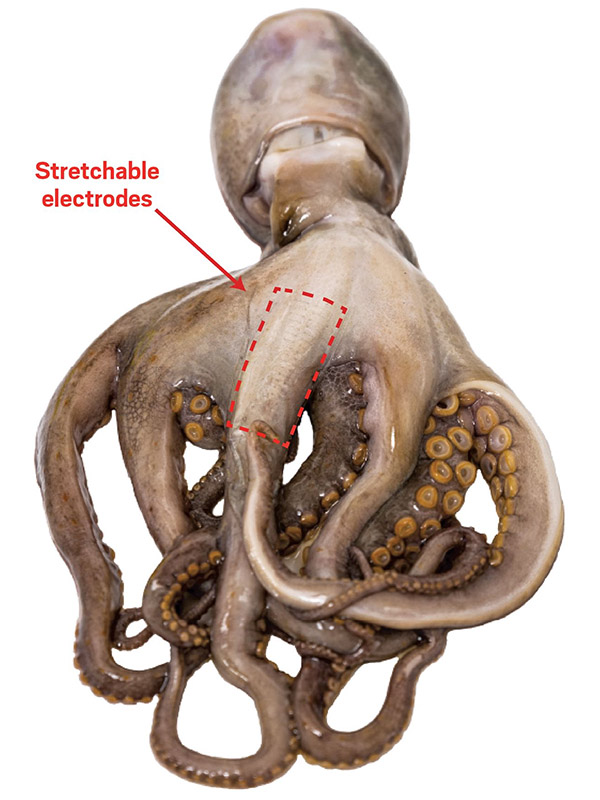These quirky discoveries caught the attention of C&EN editors this year
by Krystal Vasquez
PEPTO-BISMOL MYSTERY

Credit: Nat. Commun.
Bismuth subsalicylate's structure (Bi = pink; O = red; C = gray)
This year, a team of researchers from Stockholm University cracked a century-old mystery: the structure of bismuth subsalicylate, the active ingredient in Pepto-Bismol (Nat. Commun. 2022, DOI: 10.1038/s41467-022-29566-0). Using electron diffraction, the researchers found that the compound is arranged in rodlike layers. Along the center of each rod, oxygen anions alternate between bridging three and four bismuth cations. The salicylate anions, meanwhile, coordinate to bismuth through either their carboxylic or phenolic groups. Using electron microscopy techniques, the researchers also discovered variations in the layer stacking. They believe this disordered arrangement might explain why bismuth subsalicylate’s structure has managed to evade scientists for so long.

Credit: Courtesy of Roozbeh Jafari
Graphene sensors adhered to the forearm can provide continuous blood pressure measurements.
BLOOD PRESSURE TATTOOS
For over 100 years, monitoring your blood pressure has meant having your arm squeezed with an inflatable cuff. One downside of this method, however, is that each measurement represents only a small snapshot of a person’s cardiovascular health. But in 2022, scientists created a temporary graphene “tattoo” that can continuously monitor blood pressure for several hours at a time (Nat. Nanotechnol. 2022, DOI: 10.1038/s41565-022-01145-w). The carbon-based sensor array operates by sending small electrical currents into the wearer’s forearm and monitoring how the voltage changes as the current moves through the body’s tissues. This value correlates with changes in blood volume, which a computer algorithm can translate into systolic and diastolic blood pressure measurements. According to one of the study’s authors, Roozbeh Jafari of Texas A&M University, the device would offer doctors an unobtrusive way to monitor a patient’s heart health over extended periods. It could also help medical professionals filter out extraneous factors that impact blood pressure—like a stressful visit to the doctor.
HUMAN-GENERATED RADICALS

Credit: Mikal Schlosser/TU Denmark
Four voluneers sat in a climate-controlled chamber so researchers could study how humans affect indoor air quality.
Scientists know that cleaning products, paint, and air fresheners all affect indoor air quality. Researchers discovered this year that humans can, too. By placing four volunteers inside a climate-controlled chamber, a team discovered that natural oils on people’s skin can react with ozone in the air to produce hydroxyl (OH) radicals (Science 2022, DOI: 10.1126/science.abn0340). Once formed, these highly reactive radicals can oxidize airborne compounds and produce potentially harmful molecules. The skin oil that participates in these reactions is squalene, which reacts with ozone to form 6-methyl-5-hepten-2-one (6-MHO). Ozone then reacts with 6-MHO to form OH. The researchers plan to build upon this work by investigating how levels of these human-generated hydroxyl radicals might vary under different environmental conditions. In the meantime, they hope these findings will make scientists rethink how they assess indoor chemistry, since humans are not often seen as sources of emissions.
FROG-SAFE SCIENCE
To study the chemicals that poison frogs excrete to defend themselves, researchers need to take skin samples from the animals. But existing sampling techniques often harm these delicate amphibians or even require euthanasia. In 2022, scientists developed a more humane method to sample the frogs using a device called the MasSpec Pen, which uses a pen-like sampler to pick up alkaloids present on the back of the animals (ACS Meas. Sci. Au 2022, DOI: 10.1021/acsmeasuresciau.2c00035). The device was created by Livia Eberlin, an analytical chemist at the University of Texas at Austin. It was originally meant to help surgeons differentiate between healthy and cancerous tissues in the human body, but Eberlin realized the instrument could be used to study frogs after she met Lauren O’Connell, a biologist at Stanford University who studies how frogs metabolize and sequester alkaloids.

Credit: Livia Eberlin
A mass spectrometry pen can sample the skin of poison frogs without harming the animals.

Credit: Science/Zhenan Bao
A stretchy, conductive electrode can measure the electrical activity of an octopus's muscles.
ELECTRODES FIT FOR AN OCTOPUS
Designing bioelectronics can be a lesson in compromise. Flexible polymers often become rigid as their electrical properties improve. But a team of researchers led by Stanford University’s Zhenan Bao came up with an electrode that is both stretchy and conductive, combining the best of both worlds. The pièce de résistance of the electrode is its interlocking sections—each section is optimized to be either conductive or malleable so as not to counteract the properties of the other. To demonstrate its abilities, Bao used the electrode to stimulate neurons in the brain stem of mice and measure the electrical activity of an octopus’s muscles. She showcased the results of both tests at the American Chemical Society’s Fall 2022 meeting.
BULLETPROOF WOOD

Credit: ACS Nano
This wooden armor can repel bullets with minimal damage.
This year, a team of researchers led by Huazhong University of Science and Technology’s Huiqiao Li created a wood armor strong enough to deflect a bullet shot from a 9 mm revolver (ACS Nano 2022, DOI: 10.1021/acsnano.1c10725). The wood’s strength comes from its alternating sheets of lignocellulose and a cross-linked siloxane polymer. The lignocellulose resists fracturing thanks to its secondary hydrogen bonds, which can re-form when broken. Meanwhile, the pliable polymer becomes sturdier when hit. To create the material, Li drew inspiration from pirarucu, a South American fish with skin tough enough to withstand a piranha’s razor-sharp teeth. Because the wooden armor is lighter than other impact-resistant materials, such as steel, the researchers believe the wood could have military and aviation applications.
Post time: Dec-19-2022

